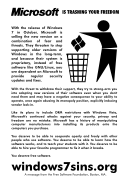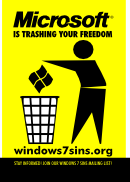Windows 7 Sins: The case against Microsoft and proprietary software
The new version of Microsoft's Windows operating system, Windows 7, has the same problem that Vista, XP, and all previous versions have had -- it's proprietary software. Users are not permitted to share or modify the Windows software, or examine how it works inside.
The fact that Windows 7 is proprietary means that Microsoft asserts legal control over its users through a combination of copyrights, contracts, and patents. Microsoft uses this power to abuse computer users. At windows7sins.org, the Free Software Foundation lists seven examples of abuse committed by Microsoft.
We've mailed a letter to 499 of the Fortune 500 companies (we didn't think Microsoft would listen), but that's just the start...
We've also mailed another letter to 500 non-profit groups around the world.
This letter writing campaign has ended. You can get involved in our current campaign to upgrade people from Windows to GNU/Linux at www.fsf.org/windows.
Send us your suggestions for organizations who would benefit from our letter.
1. Poisoning education: Today, most children whose education involves computers are being taught to use one company's product: Microsoft's. Microsoft spends large sums on lobbyists and marketing to corrupt educational departments. An education using the power of computers should be a means to freedom and empowerment, not an avenue for one corporation to instill its monopoly.
2. Invading privacy: Microsoft uses software with backward names like Windows Genuine Advantage to inspect the contents of users' hard drives. The licensing agreement users are required to accept before using Windows warns that Microsoft claims the right to do this without warning.
3. Monopoly behavior: Nearly every computer purchased has Windows pre-installed -- but not by choice. Microsoft dictates requirements to hardware vendors, who will not offer PCs without Windows installed on them, despite many people asking for them. Even computers available with other operating systems like GNU/Linux pre-installed often had Windows on them first.
4. Lock-in: Microsoft regularly attempts to force updates on its users, by removing support for older versions of Windows and Office, and by inflating hardware requirements. For many people, this means having to throw away working computers just because they don't meet the unnecessary requirements for the new Windows versions.
5. Abusing standards: Microsoft has attempted to block free standardization of document formats, because standards like OpenDocument Format would threaten the control they have now over users via proprietary Word formats. They have engaged in underhanded behavior, including bribing officials, in an attempt to stop such efforts.
6. Enforcing Digital Restrictions Management (DRM): With Windows Media Player, Microsoft works in collusion with the big media companies to build restrictions on copying and playing media into their operating system. For example, at the request of NBC, Microsoft was able to prevent Windows users from recording television shows that they have the legal right to record.
7. Threatening user security: Windows has a long history of security vulnerabilities, enabling the spread of viruses and allowing remote users to take over people's computers for use in spam-sending botnets. Because the software is secret, all users are dependent on Microsoft to fix these problems -- but Microsoft has its own security interests at heart, not those of its users.
You can help!
Free software operating systems like GNU/Linux can do the same jobs as Windows, but they encourage users to share, modify, and study the software as much as they want. This makes using a free software operating system the best way for users to escape Microsoft and avoid becoming victims of these seven sins. Software and computers will always have problems, but by using free software, users and their communities are empowered to fix problems for themselves and each other.
You can get more information about each of the sins and how to escape them at fsf.org/campaigns/windows. Please sign up there for campaign news and action alerts to help raise awareness about Microsoft's abuses, the problems with Windows, and the importance of free software!
How we got here
Two years ago, Microsoft released Windows Vista, to little fanfare and much disappointment, both from users, facing a battle of broken software, drivers and heavy restrictions, and from developers, scrambling to bring software up-to-date to work with the new system.
Two years later, Microsoft itself admits Vista failed. Users were not ready to accept the huge downgrade that Vista offered, and Microsoft has attempted to rectify this with the announcement of Windows 7. Windows 7, like Windows XP in 2001, has a more modest requirement footprint, making it ideal for low-powered netbook computers. However, unlike Windows XP, Microsoft have deliberately crippled Windows 7, leaving netbook users at the mercy of Microsoft to control which applications they can use, as well as the number of applications that can be run simultaneously.
Microsoft is up to their usual tricks again -- only this time, they're also inserting artificial restrictions into the operating system itself. While not the first time they've done this, this is the first release of Windows that can magically remove limitations instantly upon purchasing a more expensive version from Microsoft.
This is not new, however. In 1996, a furor erupted over Microsoft Windows NT. At the time, Microsoft was selling two versions of its operating system: Windows NT Workstation and Windows NT Server. The server version cost roughly $800 more than the workstation edition of the operating system.
While Windows NT Server included a series of server applications not bundled with NT Workstation, Microsoft maintained that the operating systems themselves were, "two very different products intended for two very different functions." NT Server, Microsoft claimed, was suited and tailored for use as an Internet server while NT Workstation was grossly inadequate. Aiming to enforce this difference, both the NT Workstation code and the license agreement restricted users to no more than ten concurrent TCP/IP (i.e., Internet) connections; while NT Server remained unlimited.
Many users noticed that both versions of Windows NT were very similar. Digging further, an analysis published by O'Reilly and Associates revealed that the kernel, and in fact every binary file included in NT Workstation, was identical to those shipped in NT Server. The sole difference between the two products' cores lay in the operating systems' installation information -- the server version contained several options or flags that marked it as either 'Workstation' or 'Server'. If the machine was flagged as 'Workstation', it would disable certain functionality and limit the number of network connections.
We call such limitations, antifeatures. An antifeature is functionality that a technology developer will charge users to not include -- it is more difficult for Microsoft to limit Internet connections than it is to leave them unconstrained -- and the limit is not something that any user would request.
Unfortunately, for the companies and individuals trying to push antifeatures, users increasingly often have alternatives in free software. Software freedom, it turns out, makes antifeatures impossible in most situations. Microsoft's predatory NT pricing is impossible for GNU/Linux, where users can program around it.
A version of Firefox funded by advertisements would be too--users would simply build and share a version of the software without the antifeatures in question.
Ultimately, the absence of similar antifeatures form some of the easiest victories for free software. It does not cost free software developers anything to avoid antifeatures. In many cases, doing nothing is exactly what users want and what proprietary software will not give them.
Resources
We'll be adding more soon. If you have a flyer to contribute, please send it to campaigns@fsf.org.




